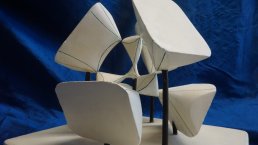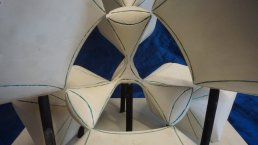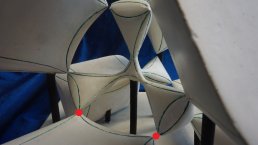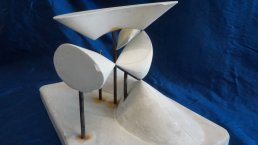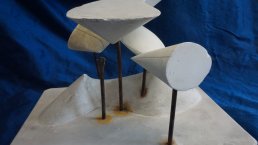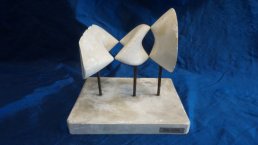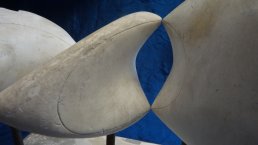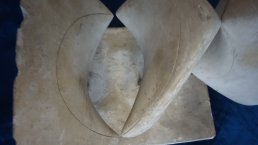Kummer Surfaces
Double Points and Kummer Surfaces
A quartic surface (defined by a degree 4 polynomial) in $\mathbb{P}^3$ (see projective space) can have at most 16 "ordinary double points" (a special type of singularity) [1]. Quartic surfaces with 16 double points are called "Kummer surfaces". These points have an interesting configuration: there are 16 planes which each contain 6 double points, and through every double point there pass 6 planes. Each of these planes, known as a "double plane", intersects the Kummer surface in a conic (a degree two curve). Defined in terms of intersection theory, a double plane meets "with intersection multiplicity two". In less technical terminology, this means that the plane is tangent to the surface at the double points it meets.
Models Exhibiting Double Points
Model II 1a of a Kummer surface has the remarkable property that all of its 16 double points and 16 double planes are real (recall discussion in Singularities). It can be seen that the six double points towards the bottom of the model are coplanar, with a horizontal double-plane. Some of them are annotated on the right hand image below. The conics of intersection are visible as the green curves on the model.
Model II 1b has 8 real double points, and 8 real double planes. Each of these planes contains four real points, and each real point meets 4 real planes. The conics of intersection are visible as the green curves on the model.
Model II 1c has 4 real double points and 4 real double planes. Each such point meets 2 real double planes, and each real double plane meets 2 real double points.
Alongside these three models, Fresnel's wave surface completes the collection in terms of a topological classification. We have all possible topological types of Kummer surface (with at least one double point) as classified by German mathematician Karl Rohn [2]. There can be either 0, 2, 4, 8, or 16 double points.
Some degenerate cases of (real) Kummer surfaces include a "double sphere", Steiner's Roman surface, and the union of four planes - see Max Kutler's paper [3] for more on Kummer surfaces.
References
[1] E. Kummer, "Über die Flächen vierten Grades mit sechzehn singulären Punkten" (1864), Monatsberichte der Königlichen Preußischen Akademie der Wissenschaften zu Berlin: 246–260
[2] K. Rohn, Die verschiedenen Gestalten der Kummer'schen Fläche. In: Mathematische Annalen. 18. Band. Leipzig (1881), S. 99–159. http://gdz.sub.uni-goettingen.de/no_cache/dms/load/img/?IDDOC=26284
[3] Max Kutler, Kummer Surfaces (2010), https://www.math.hmc.edu/~ursula/teaching/math189/finalpapers/max.pdf


